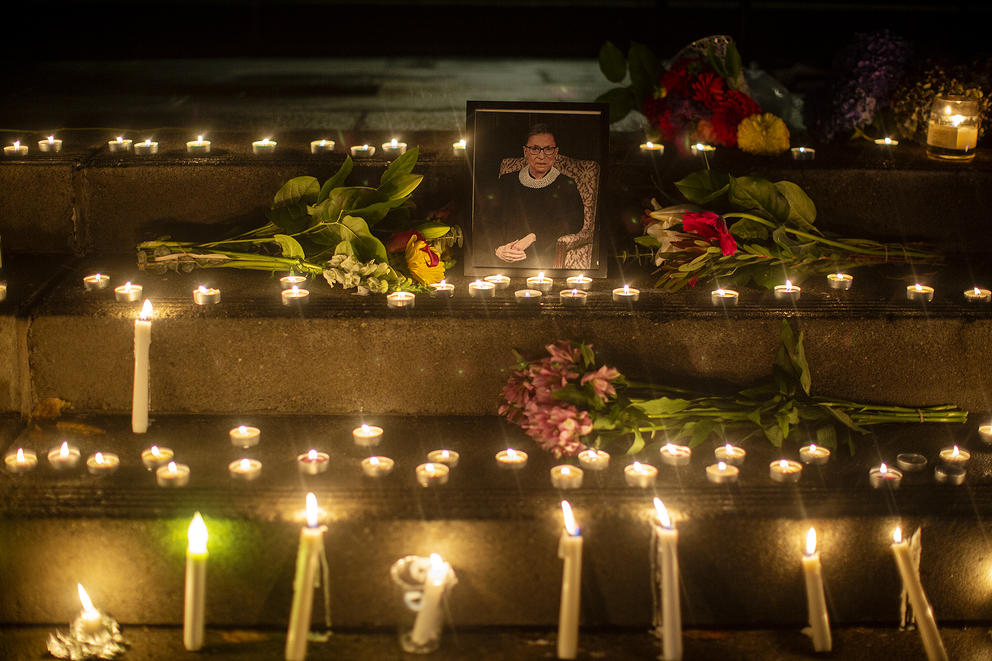I served as a law clerk for Justice Ginsburg (“the Boss”) for only one year, a long time ago in 2002. It was, literally, a life-altering experience. I was deeply influenced by Justice Ginsburg’s precise, clear-sighted view of the law and her belief in the Constitution as a living document. I even absorbed the justice’s grammatical quirks. RBG had zero patience — less than zero — for people who said “hone” when they meant “home,” and after almost 20 years I still flinch at that error. But now that she is gone, I realize that I absorbed much more than law and rhetoric from Justice Ginsburg. I can’t help but view her passing, and the events surrounding it, through what I imagine are her eyes. And Ruth Bader Ginsburg does not panic.
I first met Justice Ginsburg in December 2000, after flying from Montana to Washington, D.C., through wild Midwestern snowstorms to interview for a job with her. On the eve of my interview, the Supreme Court handed down its decision in Bush v. Gore. The justice issued her famous dissent. Soon after, she was talking with me. The justice knew the stakes in Bush v. Gore, both for the court and for the country. In some ways, Bush v. Gore was the first brick in the walls — of polarization, of entrenchment — that now surround us. Yet my interview with her was warm and relaxed. I don’t think she was showing steely resolve, or false grace, or that she was in denial. She was simply focused on the tasks at hand. And one of those tasks — a small and simple one — was me.
Two decades later, I cannot emulate many of RBG’s extraordinary qualities. Of course, I am not her equal in law, or strategy. But in other things, too, I fall short. I try to share her deep sense of collegiality — her commitment to the meaning, and not only the surface, of etiquette — but I don’t always succeed. I cannot even aspire to her sense of style. Justice Ginsburg’s chambers were light, airy and modern, full of abstract art and gifts from friends and family — a form of design rebellion against the tome-lined mahogany shelves of the prototypical jurist. Meanwhile, I am plotting to replace our Ikea sectional. And I still lack her appreciation for opera. My year, she took the four of us clerks to a matinée of Aida, and the only part I truly enjoyed was seeing how much the justice enjoyed it.
But in important respects, I have absorbed deep and important lessons from RBG. She took joy in her life, despite legal and personal setbacks, and I try to do the same. This weekend, rather than stewing over social media or stress-eating brownies, I went swimming in Lake Washington and had a great time with my friends and family. (If I happened to eat a brownie or two, that was just a coincidence.) And, like her, I aspire to find meaning in my life through public service. This week, I am thrilled to welcome a new class to the University of Washington School of Law, where I teach.
We cannot all be as extraordinary as RBG. That, after all, is not how statistics work. But she dedicated her time with us toward creating a better world for everyone. And in doing that, she stayed focused on the tasks at hand. She did not panic. Each of us can try to live up to that.
Justice Ginsburg became only the second woman to serve on the Supreme Court, a fact she called a bad look for the court. Over her career as an attorney, she argued many cases on the inequality of the sexes and earned a reputation as a “feminist lawyer,” taking on cases others would not and presenting in great detail how women were not treated equally to men in all facets of society. Decades later, on the high court, she became the de facto leader of the liberal block and wrote impassioned decisions and dissents on the merits of issues before the court. (Shaminder Dulai/Crosscut)





